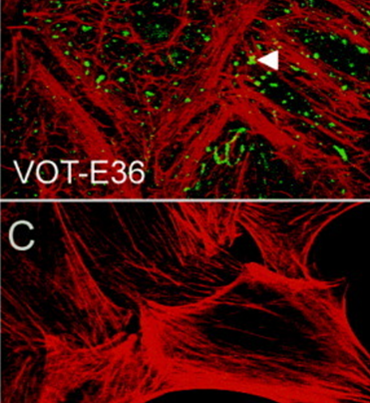The research tool: The Kinase Chemogenomic Set (KCGS)
There are approximately 518 kinases encoded within the genome but for over 150 of these, their substrate is unknown, leaving much of the kinome poorly annotated and little understood with respect to its role in human biology.
Dysregulation of kinases is a leading cause of oncogenesis and disease including immune, neurological, and infectious ailments. Disruption of kinase activity, be it upregulation or deactivation, can impact cell survival, proliferation or migration. However, 90% of the current research effort has been expended on only 20% of known kinases.
Understanding the remaining unstudied ‘dark’ kinases is essential to provide opportunities to discover new drug targets and diagnostic tools. Yet, there is still a lack of research tools/resources dedicated to these kinases.

The contributor
University of North Carolina at Chapel Hill (UNC) & Structural Genomics Consortium (SGC)
Developing a new tool kit
The Structural Genomics Consortium (SGC) is a non-profit organisation and home to scientists from medicinal chemistry, cell biology, and chemical biology. The SGC recognised the need to focus on the chemical biology of protein kinases. Operating out of the UNC Eshelman School of Pharmacy, these researchers have combined their skills to develop small molecule inhibitors aimed at ‘dark’ kinases to understand their structure, substrate, and function. This work resulted in the creation of the Kinase Chemogenomic Set (KCGS).

Introducing the Kinase Chemogenomic Set (KCGS)
The Kinase Chemogenomic Set (KCGS) is the most diverse and highly-annotated, publicly-available collection of kinase inhibitors. Version 1.0 of the set contains 187 kinase inhibitors with potent activity on 215 human kinases, sourced from eight pharma companies and leading academic laboratories. Version 2.0 has currently replaced version 1.0, which features 108 additional kinase inhibitors, for a total of 295 kinase inhibitors.
KCGS helps scientists identify medically important kinases and allows for the synthesis of high-quality chemical probes for high-priority dark kinases of therapeutic interest. Each inhibitor has been cross-screened across hundreds of kinases – only those meeting strict selectivity criteria are included in the set.
The use of these chemical inhibitors alongside screening assays will help uncover the biology of these unknown/dark proteins in both health and disease. Preliminary characterisation of the KCGS in phenotypic screens showed its potential for chemogenomic exploration of kinase signaling, which could lead to new targets for drug discovery and precursors to new medicines.
KCGS impact
The KCGS set can be used in oncology and other life science research. A number of research projects have already made use of the KCGS to reduce the manual labour of sourcing and cross-screening each inhibitor across hundreds of kinases. Here are some of their results:
”greatly benefited from using KCGS in investigating cellular mechanisms of drug resistance in cancer by the application of chemogenomic libraries to discover novel kinase targets for pancreatic cancer treatment. KCGS has opened up new programs to study the viral-induced kinome and the discovery of small molecule inhibitors as potential anti-viral drugs
Lee Graves, UNC School of Medicine
Patrick Eyer, Institute of Integrative Biology
Using the KCGS has shaken up investigation into the phosphoproteome. Patrick Eyers from the Institute of Integrative Biology was studying how covalent inhibitors of EGFR family protein kinases induce degradation of human Tribbles 2 (TRIB2) pseudokinae in cancer cells [3].
”KCGS has changed how we think about targeting unusual protein kinases, including pseudokinases and conformationally-restricted canonical kinases, with small molecules
Patrick Eyer, Institute of Integrative Biology
Daniel Ebner, University of Oxford
Using the KCGS, Daniel Ebner, has been able to identify kinase targets in neurodegeneration, cancer, wound healing, inflammation and cardiovascular disease [1], leading to several manuscripts already in publication. For example, thanks to KCGS, a novel synthetic lethal interaction between cyclin F loss and Chk1 inhibition was discovered, paving the way for patient selection in the clinical use of checkpoint inhibitors [2]
Discover how you can benefit from KCGS:
References
[1] Wells, CI. et al. 2021. Int J Mol Sci. 22(2):566. PMID: 33429995
[2] Burdova, K. et al. 2019. EMBO J. 38(20):e101443. PMID: 3142411
[3] Foulkes, D.M. et al. 2018. Sci Signal. 11 (549): eaat7951. PMID: 30254057.





